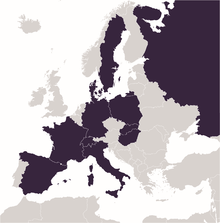European x-ray free electron laser
Coordinates: 53°35′20″N 9°49′44″E / 53.589°N 9.829°E
 | |
| Fundamental research | |
| Headquarters | Hamburg |
| Website |
www |

The European x-ray free electron laser (European XFEL) is an X-ray research laser facility currently in commissioning. The first laser pulses were produced in May 2017; the facility is scheduled to start user operation in September 2017.[1][2] The international project with 11 participating countries[3] (Denmark, France, Germany, Hungary, Italy, Poland, Russia, Slovakia, Spain, Sweden and Switzerland) is located in the German federal states of Hamburg and Schleswig-Holstein.[4] A free-electron laser generates high-intensity electromagnetic radiation by accelerating electrons to relativistic speeds and directing them through special magnetic structures. The European XFEL is constructed such that the electrons produce x-ray light in synchronisation, resulting in high-intensity x-ray pulses with the properties of laser light and at intensities much brighter than those produced by conventional synchrotron light sources.
Location
The 3.4 km long tunnel for the European XFEL housing the superconducting linear accelerator and photon beamlines runs 6 to 38 m underground from the site of the DESY research center in Hamburg to the town of Schenefeld in Schleswig-Holstein, where the experimental stations, laboratories and administrative buildings are located.[5]
Accelerator
Electrons are accelerated to an energy of up to 17.5 GeV by a 2.1 km long linear accelerator with superconducting RF-cavities.[5] The use of superconducting acceleration elements developed at DESY allows up to 27,000 repetitions per second, significantly more than other x-ray lasers in the US and Japan can achieve.[6] The electrons are then introduced into the magnetic fields of special arrays of magnets called undulators, where they follow curved trajectories resulting in the emission of x-rays in the range of 0.05 to 4.7 nanometres.[5]
Laser
The x-ray light is generated by Self-Amplified Spontaneous Emission (SASE), where electrons interact with the radiation that they or their neighbours emit. The result is spontaneous emission of tightly bunched packages of radiation that are amplified like laser light. The peak brilliance of the European XFEL will be billions of times higher than that of conventional x-ray light sources, the average brilliance being 10,000 times higher.[5] The higher electron energy allows the production of shorter wavelengths.[6] The duration of the light pulses will be less than 100 femtoseconds.[5]
Research
The short pulses make it possible to measure chemical reactions that are too rapid to be captured by other methods. The wavelength of the x-ray laser may be varied from 0.05 to 4.7 nanometers, enabling measurements at the atomic length scale.[5]
Initially, 3 photon beamlines with a total of 6 experimental stations (later to be upgraded to 5 photon beamlines and 10 experimental stations) are foreseen. The proposed experimental beamlines will enable unique scientific experiments exploiting the high intensity, coherence and time structure of the new source to be conducted in a variety of disciplines spanning physics, chemistry, materials science, biology and nanotechnology.
Current status
The German Federal Ministry of Education and Research granted permission to build the facility on 5 June 2007 at a cost of 850 million Euro, under the provision that it should be financed as a European project.[7] The European XFEL GmbH that built and operates the facility has been founded in 2009.[8] Civil construction of the facility began on 8 January 2009.[9] Construction of the tunnels was completed in summer 2012,[10] and all underground construction was completed the following year.[11] The first beams were accelerated in April 2017, and the first x-ray beams were produced in May 2017.[1][2] The overall cost for the construction and commissioning of the facility is as of 2017 estimated at 1.22 billion Euros (price levels of 2005).[5]
References
- 1 2 "World's biggest ever X-ray laser shines its first light". 2017-05-04. Retrieved 2017-05-04.
- 1 2 "Größter Röntgenlaser der Welt erzeugt erstes Laserlicht" (in German). 2017-05-04. Retrieved 2017-05-04.
- ↑ "European XFEL - Organization - Company - Shareholders". www.xfel.eu. Retrieved 2017-05-28.
- ↑ "DESY's European XFEL project group". Retrieved 2007-12-20.
- 1 2 3 4 5 6 7 "European XFEL facts & figures". Retrieved 2017-05-04.
- 1 2 "European XFEL in comparison". Retrieved 2017-05-04.
- ↑ "Launch of the European XFEL".
- ↑ European XFEL news: "HRB 111165: The European XFEL GmbH has been founded!"
- ↑ European XFEL news: "Construction news: Schedule for civil engineering works"
- ↑ European XFEL news: "Tunnel construction completed"
- ↑ European XFEL news: "European XFEL underground construction completed"
External links
| Wikimedia Commons has media related to European XFEL. |